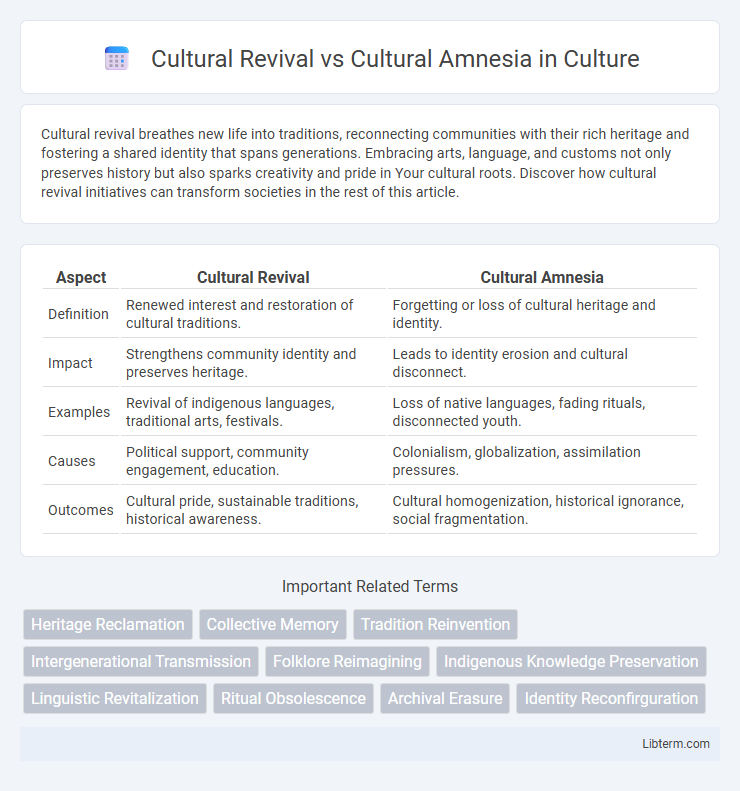Cultural revival breathes new life into traditions, reconnecting communities with their rich heritage and fostering a shared identity that spans generations. Embracing arts, language, and customs not only preserves history but also sparks creativity and pride in Your cultural roots. Discover how cultural revival initiatives can transform societies in the rest of this article.
Table of Comparison
| Aspect | Cultural Revival | Cultural Amnesia |
|---|---|---|
| Definition | Renewed interest and restoration of cultural traditions. | Forgetting or loss of cultural heritage and identity. |
| Impact | Strengthens community identity and preserves heritage. | Leads to identity erosion and cultural disconnect. |
| Examples | Revival of indigenous languages, traditional arts, festivals. | Loss of native languages, fading rituals, disconnected youth. |
| Causes | Political support, community engagement, education. | Colonialism, globalization, assimilation pressures. |
| Outcomes | Cultural pride, sustainable traditions, historical awareness. | Cultural homogenization, historical ignorance, social fragmentation. |
Understanding Cultural Revival: Definition and Significance
Cultural revival refers to the intentional process of rediscovering, preserving, and reinvigorating the traditions, languages, and art forms of a community or society that have been diminished or forgotten. This phenomenon plays a crucial role in reinforcing cultural identity, fostering social cohesion, and promoting historical continuity amidst globalization and modernization pressures. Recognizing and supporting cultural revival efforts contribute to safeguarding intangible cultural heritage and empowering marginalized groups to reclaim their cultural narratives.
The Roots and Causes of Cultural Amnesia
Cultural amnesia stems from historical trauma, colonization, and political suppression that disrupt intergenerational knowledge transmission, leading to the loss of traditional languages, customs, and identities. Factors such as globalization and forced assimilation policies exacerbate cultural erosion by prioritizing dominant cultures over marginalized ones. Understanding the roots of cultural amnesia is essential to fostering cultural revival movements that aim to reclaim and revitalize suppressed heritage through education, art, and community engagement.
Historical Examples of Cultural Revival Movements
The Irish Literary Revival in the late 19th and early 20th centuries exemplifies a powerful cultural revival movement aimed at restoring Irish language, literature, and traditions suppressed under British rule. Similarly, the Harlem Renaissance of the 1920s revitalized African American cultural identity through art, music, and literature, counteracting the erasure caused by systemic racism and cultural amnesia. These movements demonstrate how reclaiming cultural heritage fosters national pride and counters historical neglect or oppression.
Factors Driving Societal Cultural Disconnect
Rapid urbanization, technological advancements, and globalization serve as primary factors driving societal cultural disconnect, leading to cultural amnesia where traditional practices and languages are marginalized. The erosion of intergenerational communication and the dominance of homogenized media content further exacerbate detachment from cultural roots. Economic pressures and educational systems prioritizing standardized curricula also contribute to the diminishing collective memory, hindering cultural revival efforts.
The Role of Education in Reviving Heritage
Education plays a crucial role in cultural revival by integrating heritage studies into curricula, fostering awareness and appreciation of traditional customs and languages. Immersive programs and community-based learning initiatives help bridge generational gaps, ensuring the transmission of cultural knowledge to younger populations. Without educational support, cultural amnesia deepens, risking the loss of identity and historical continuity within societies.
Globalization: Bridge or Barrier for Cultural Memory?
Globalization acts as both a catalyst for cultural revival and a trigger for cultural amnesia by facilitating widespread exchange of traditions while risking homogenization of distinct identities. Digital platforms amplify global awareness of endangered cultures, promoting preservation efforts, yet mass media can overshadow localized narratives causing cultural memory erosion. Strategic cultural policies and community engagement are essential to leverage globalization as a bridge that strengthens cultural memory rather than a barrier that erases it.
Digital Media’s Influence on Cultural Retention and Loss
Digital media profoundly shapes cultural retention and loss by enabling widespread access to traditional practices, languages, and arts, fostering cultural revival through platforms like social media, digital archives, and virtual communities. Conversely, the overwhelming dominance of globalized content risks cultural amnesia as localized customs and narratives diminish, replaced by homogenized digital experiences. The interplay between digital preservation efforts and cultural homogenization highlights the critical role of technology in either sustaining or eroding cultural identities.
Indigenous Voices: Restoring Endangered Traditions
Indigenous communities worldwide are spearheading cultural revival efforts to restore endangered traditions through language revitalization, traditional arts, and oral histories, combating the effects of cultural amnesia caused by colonization and forced assimilation. Initiatives such as the Maori language nests in New Zealand and the Navajo Code Talkers' legacy highlight the resilience and importance of preserving Indigenous knowledge. Empowering Indigenous voices fosters intergenerational transmission of heritage, ensuring that cultural identity and ancestral wisdom endure despite historical erasure.
Policy Strategies for Preventing Cultural Amnesia
Policy strategies for preventing cultural amnesia emphasize the preservation and promotion of indigenous languages, heritage education, and archival documentation. Governments implement cultural funding programs, support traditional arts, and integrate cultural history into school curriculums to ensure intergenerational knowledge transfer. Digital preservation initiatives and community-led storytelling projects serve as vital tools for maintaining living cultural memory and resisting cultural erasure.
Future Directions: Balancing Revival and Modernization
Future directions in cultural preservation emphasize balancing revival efforts with modernization to ensure traditions remain relevant and dynamic. Integrating digital technologies and global communication platforms can promote cultural heritage while adapting to contemporary contexts. Sustainable cultural policies foster innovation without erasing historical identity, enabling communities to thrive amid rapid social change.
Cultural Revival Infographic

 libterm.com
libterm.com